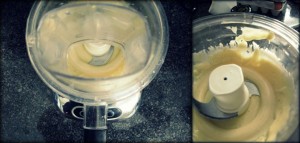You can find lots of Paleo recipes for making your own mayo, but they mainly use coconut oil or olive oil. That’s some expensive stuff. So it got me thinking– how about utilizing a nourishing fat source that most people throw away? Cheap, resourceful and easy–who doesn’t like that?
Ingredients
- 1/2 c liquid (but NOT hot) bacon fat*
- 1 egg yolk (if you use local, pasture raised chicken eggs, you don’t have to worry about bacteria)
- 1 t Dijon mustard or vinegar or lemon juice
Method
Put the egg yolk, mustard and vinegar in the smallest bowl of your food processor. Start the blade running and slowly add the bacon fat. Slowly means–take spoonful of fat and add a single drop into the bowl of the food processor. Once that has combined, add another drop. You should start to see an emulsion forming. At this point, you can add the fat as a slow drizzle. Continue until all the fat is gone. The mayo is finished when it’s creamy and a little thick. All in all, it’ll take about 6 minutes.
*Heat the oven to 350. Place 8 slices of bacon on a baking sheet and cook until browned about 25 minutes. Remove the bacon from the pan and reserve it for another recipe. What’s left should be about 1/2c of rendered bacon fat. Make sure the fat has cooled down a bit before making the mayo.

Leave a Reply